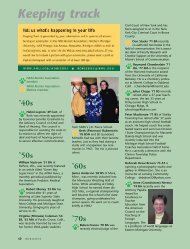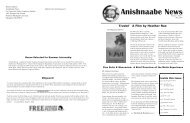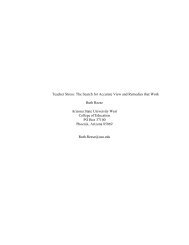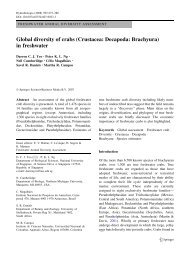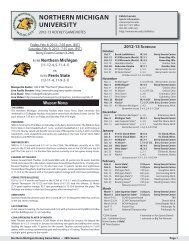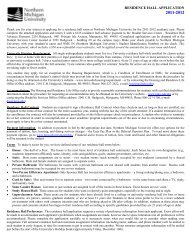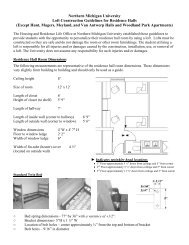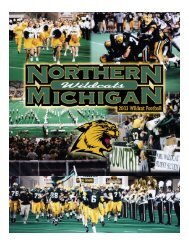- Page 1 and 2: NATIVE AMERICAN AND FRENCH SETTLEME
- Page 3 and 4: Christianity. Into this trading par
- Page 5 and 6: 14 Iroquois Intrusion 10 Huron Peop
- Page 7 and 8: Part IV: Native Accomodation and Re
- Page 9 and 10: NATIVE AMERICAN AND FRENCH SETTLEME
- Page 11 and 12: the Straits of Mackinac including t
- Page 13 and 14: that no vestige of them now remains
- Page 15 and 16: seeking and eventually contacting t
- Page 17 and 18: The first Jesuit missionaries visit
- Page 19 and 20: their home.[8] Huron People. - Jesu
- Page 21 and 22: longhouses sometimes surrounded by
- Page 23 and 24: with their northern neighbors. Even
- Page 25: (Khionontateronon or Petun), Tionon
- Page 29 and 30: site was critical to the survival o
- Page 31 and 32: Iroquois. In the east a short peace
- Page 33 and 34: Marquette Leaves. - In the fall of
- Page 35 and 36: they collect from these places must
- Page 37 and 38: that they arrived at Michilimackina
- Page 39 and 40: and between six and seven thousand
- Page 41 and 42: another, and together they border a
- Page 43 and 44: It should be borne in mind that fou
- Page 45 and 46: the settlement on the north side ha
- Page 47 and 48: and Charlevoix's map of his 1721 vi
- Page 49 and 50: fishery . . . ."[43] Fishing was th
- Page 51 and 52: spawning season for the yellow wall
- Page 53 and 54: growing increasingly difficult to k
- Page 55 and 56: Retention of Native Beliefs. - Alth
- Page 57 and 58: . . . Every dance had its own name;
- Page 59 and 60: ut the soil and climatic conditions
- Page 61 and 62: this plant was utilized is not cite
- Page 63 and 64: was used as a charm and medicine. U
- Page 65 and 66: dice, the size of plum stones, were
- Page 67 and 68: Utilization As part of the importan
- Page 69 and 70: and adjoining chapel called St. Fra
- Page 71 and 72: trader -- in the middle and lower-
- Page 73 and 74: Father Carheil, who was stationed a
- Page 75 and 76: himself in the struggle against the
- Page 77 and 78:
Franquelin in mapping the New Engla
- Page 79 and 80:
in two ways: by selling unlimited q
- Page 81 and 82:
court a new program for the west wh
- Page 83 and 84:
sales are unknown. Through 1701 his
- Page 85 and 86:
Iroquois, deal with French commerci
- Page 87 and 88:
even be killed for their trespass.
- Page 89 and 90:
War with the Iroquois and Western M
- Page 91 and 92:
and ammunition the Odawa and Huron
- Page 93 and 94:
est known and most successful trade
- Page 95 and 96:
ecord is studied it is found to con
- Page 97 and 98:
children, and some few superannuate
- Page 99 and 100:
presides over [Lake Huron]."[93] At
- Page 101 and 102:
own men opposed it as much as they
- Page 103 and 104:
COMMERCIAL POLICIES: Northern PART
- Page 105 and 106:
means adopted to carry out the poli
- Page 107 and 108:
confiding in the allies or giving n
- Page 109 and 110:
eturned to their homes. French infl
- Page 111 and 112:
effective when it was known that ei
- Page 113 and 114:
peace with the Five Nations, whose
- Page 115 and 116:
t i e d s e c u r e l y t h a n
- Page 117 and 118:
f a t e f u l w o o d s - e d g e c
- Page 119 and 120:
t e d t h a t h e h a d a c t e
- Page 121 and 122:
e n o n v i l l e t h a n a n I r
- Page 123 and 124:
l d s o o n p a s s t h a t w a
- Page 125 and 126:
q u o i s t h r o u g h t h e i r
- Page 127 and 128:
e n o t e d T e g a n i s s o r e n
- Page 129 and 130:
e y w e r e p e a c e e n v o y s
- Page 131 and 132:
l . K o n d i a r o n k f e i g n
- Page 133 and 134:
a g e a n d f u r y , c u r s i n
- Page 135 and 136:
a y i n g h i m i n t o b e c o
- Page 137 and 138:
f t r e a c h e r y . T h e n t h
- Page 139 and 140:
e r s a n d T e g a n i s s o r e n
- Page 141 and 142:
killed the peace; we shall see how
- Page 143 and 144:
ut Baron de LaHontan, held Kondiaro
- Page 145 and 146:
soundly crushed the Iroquois. The i
- Page 147 and 148:
power." Reduction in Fighting.- Wit
- Page 149 and 150:
at Michilimackinac to settle there.
- Page 151 and 152:
harvest. The Kiskakon Odawa had six
- Page 153 and 154:
leaders living in the vicinity of S
- Page 155 and 156:
aised enough maize for themselves a
- Page 157 and 158:
Lignery, had apparently been sent t
- Page 159 and 160:
seeking more arable lands which the
- Page 161:
the Indians who were settled here [
- Page 164 and 165:
their consorts. As a result, there
- Page 166 and 167:
and St. Andrew which appears as Cet
- Page 168 and 169:
in the nineteenth century it is dif
- Page 170 and 171:
and settled in St. Ignace. The patt
- Page 172 and 173:
for them.[112] It is important to r
- Page 174 and 175:
Ecology and Ethnozoology of the Upp
- Page 176 and 177:
(1974), 121-138. . "Settlement Anal
- Page 178 and 179:
de'Amerique Septentrionale (1614-17
- Page 180 and 181:
An Archaeological Perspective on th
- Page 182 and 183:
[3].James E. Fitting. "The Nelson S
- Page 184 and 185:
[14].White. "Neutral and Wenro," p.
- Page 186 and 187:
[33].Fitting. "The Gyfakis and McGr
- Page 188 and 189:
[46].JR 55:161-165. [47].Lahontan.
- Page 190 and 191:
Authority. East Lansing: The Museum
- Page 192 and 193:
Conquest," Smithsonian Institution,
- Page 194 and 195:
1:1 (1961), 10. [106].Cited in Ston




